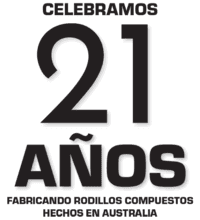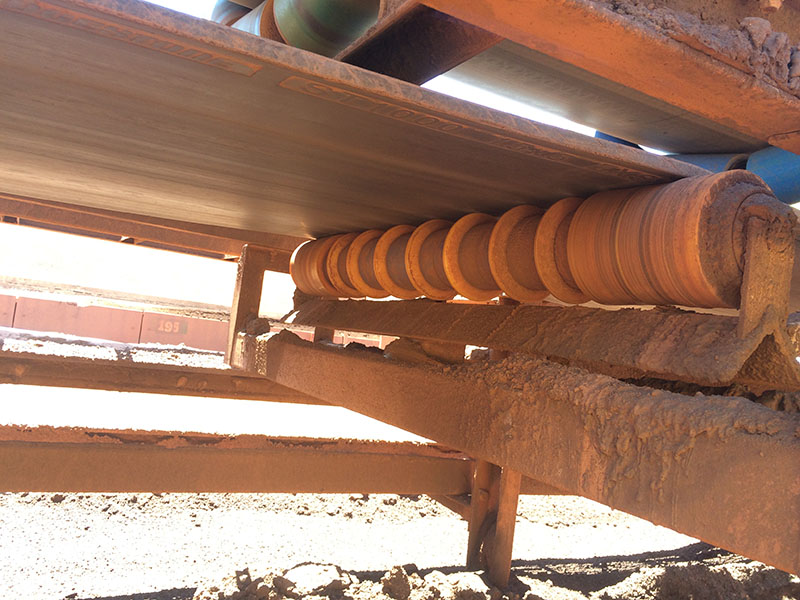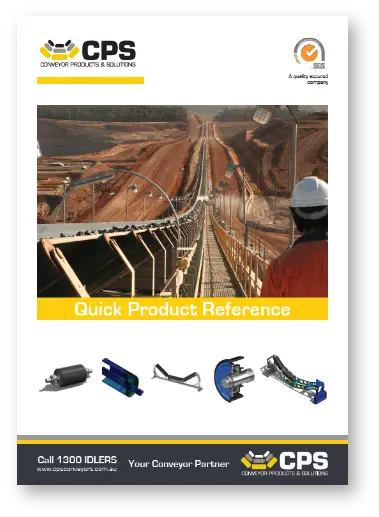Case Study: Ore Processing Facility
Posted at Agosto 31, 2018Previous problem:
The sheer volume of ore being transported over this belt, and the nature of the material, was creating extreme carry back issues. Consequently, Operations where having unscheduled shut-downs to replace failed rollers before they damaged the conveyor belt – at an enormous cost. A more cost-effective strategy was to change all rollers in these areas, every 12 weeks during the scheduled shut-downs for maintenance. The 6mm Steel return rollers where lasting between 15-36 weeks, depending on the location.
Particles that make up carryback typically have a higher moisture content than the overall conveyed material. As the belt rolls over the idlers, it vibrates, creating a setting action. The smallest moisture-rich fines sift to the bottom of the pile, where they can create an adhesive mixture that clings to the belt beyond the discharge point of the head pulley. This accounts for most of the fugitive material present in conveyor systems. Material fines become dislodged along the return run of the conveyor and buildup beneath the belt. Carryback buildup on rolling components reduces efficiency, increases maintenance costs, reduces plant safety, shortens belt life and leads to premature roller failure.
| Product – Polyurethane Rollers |
| Location – Pilbara, Western Australia |
| Conveyed Material – Iron ore |
| Belt Width – 1,800 mm |
| Belt Speed – 3.7 metres per second |
| Bulk – 10,000 tonnes per hour |
The CPS Solution
The CPS Engineering team recommended that the first 10 return frames back from head pulley on all conveyors were changed out to PU disc rollers. The CPS PU ringed rollers resulted in achieved life of +2 years and are still running today. The initial trial/test data below, was measured during shutdowns on a primary crushed ore overland belt. Wear data was collected across the face of the roller at the three ring locations, over several incremental measurement dates.
| Ubicación | Date Installed |
Wear Rate (mm/month) |
Projected C/O Date |
| Head Pulley Transition – Vee-Return | Dec 2013 | 0.50 | Oct 2055 |
| Head Pulley Transition – Vee-Return | Dec 2013 | 0.83 | Jan 2039 |
| Head Pulley Transition – Vee-Return | Dec 2013 | 0.81 | Aug 2039 |
| Head Pulley Transition – Vee-Return | Dec 2013 | 0.81 | Aug 2039 |
| Head Pulley Transition – Vee-Return | Dec 2013 | 0.81 | Aug 2039 |
| Head Pulley Transition – Vee-Return | Dec 2013 | 0.81 | Aug 2039 |
| Tail Pulley Transition – Vee-Return | Mar 2014 | 1.30 | Apr 2030 |
| Tail Pulley Transition – Vee-Return | Mar 2014 | 1.30 | Apr 2030 |
Life Cycle Cost
Generally, polyurethane ringed rollers are less expensive than rubber lagged rollers currently installed in common high-wear locations – though more expensive than the steel equivalents. Based on the above trial data, and other experience, the overall Life Cycle Cost is considerably dropped (approximately 30% of the LCC of steel rollers) due to the significant life increase. A variety of rings can be provided, based on client requirements and failure mode drivers.
Other Potential Benefits
- Ringed rollers have a tendency to assist with belt cleaning, due to the flex of the belt over the roller rings
- Ringed rollers can assist in belt training, as the largest areas of belt contact occur at the roller edges; guiding the belt into the centre
- Ringed rollers assist with maintenance requirements by providing a visual wear indicator for replacement, as wear of the rings is clearly visible during inspections



